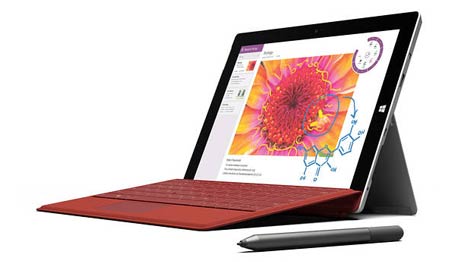Next week is Microsoft’s Build event, which should begin the ramp up to releasing Windows 10 into the market. A lot is riding on this operating system. Over the last decade, Microsoft has gone from the unbeatable giant of U.S. technology to a firm that is regularly eclipsed by both Apple and Google. In the world of BYOD, it is struggling with tablets—a segment that it initially took mainstream—and overwhelmed in smartphones. Microsoft has held on to the PC market, but is facing erosion by Apple, particularly at the lucrative high-end segment, and by Google at the low end with Chrome.
Windows 10’s purpose is to change this dynamic and once again make Microsoft a force to be reckoned with. I’ve been running Windows 10 on my PCs and phone. So, let’s talk about where it is now and where it will need to be.
Windows 10 on PCs
This is currently where Windows 10 shines. It fundamentally fixes the mistake made with Windows 8 that swapped the active tile interface for the traditional one depending on which applications you ran, instead of depending on whether you had a touch screen or not. This was like building a convertible car where the top went up or down depending on what road you drove on, not on whether you wanted the top up or down.
The latest build for PCs, which dropped this week, is impressive. Now you use the traditional interface, which works fine with touchscreens (and is icon based), and you only switch to tiles when you want to. In use, it is more like iOS or Android but with a visual twist.
With pricing changes, OEMs should be able to match price with Chrome at the low end and still build attractive PCs at the high end that outperform Apple at lower price points. Over time, iTunes has been eclipsed by a variety of music and video services like Rhapsody, Slacker, Netflix and Amazon Prime—all of which appear to be running fine on the Windows 10 beta.
Builds have been coming fast and furious as of late, with each showcasing that Microsoft is listening to users and applying aggressively the suggestions that have resonated. This is night and day better than Windows 7 and especially 8, and while Windows XP users still have an ugly upgrade path, the experience on the new platform appears worth the effort.
Windows 10 on Tablets
The tablet experience is partially hampered by the second-class status this platform gets from Amazon, as the Amazon Kindle Reader software for Windows is noticeably older than what is provided on Android or iOS. People don’t use as many apps on their tablets as they use on their smartphones, but that reader app is painful enough that it may hold some folks off from switching to this platform for their tablet. Tablets for business have been popular enough on Windows to keep adequate business app support for the platform, which still lags on entertainment apps. Otherwise, the commonality between the tablet and PC experience is mostly seamless and the level of consistency in the user experience will be highly appreciated and likely favored by Windows users.
The new Surface 3 Tablet is very competitive in performance and price, and this will likely be the strongest Windows 10 tablet offering.
Here, if the one critical app, the Amazon Kindle Reader, were updated, it would make the overall product far more acceptable as a general personal tablet replacement. And for work, the platform improves its already superior profile.
Windows 10 on Smartphones
This is where the platform lags the most and where the application gap is the most apparent. A lot of things aren’t working at the moment, from predictive typing to search. The user interface has been improved, though, and navigation is far more intuitive. So you can see the progress—it is just far behind where it would need to be to attract current Android users to the platform and iOS users would be even farther off. As the easier platform to attack since Apple’s iPhone users are almost impossible to move, Android has more apps and more phone choices. Google is aggressively turning it into an iOS killer, most recently by starting an MVNO to attack Apple where it is most vulnerable.
In this segment, Windows 10 remains overmatched and significantly so. This is where massive improvement will be needed if Microsoft is going to truly challenge the smartphone market.
Wrapping Up: Microsoft Build
At Build, we’ll get a feeling for where Windows 10 will be at launch later in the year. For PCs, it is near ready and it should do incredibly well if it is wrapped with a decent demand effort—which could be problematic given that most copies of Windows 10 will be free and cost centers often have trouble getting marketing funding. On tablets, the only glaring problem is the Amazon Kindle Reader app, which is unfortunately outside of Microsoft’s direct control. However, Microsoft remains better positioned than either Google or Apple for a business solution for tablets now that it has become more competitively priced and is providing competitive performance on its Surface 3 product line.
Smartphones need a lot of work, though. This part of the platform appears to be a generation or two back from where it needs to be, and the competitors are pretty much running flat out against each other here. I’m not convinced that anyone can catch Google or Apple from behind on smartphones, and I believe that what is needed is a disruptive change—something that gets people to see the market differently. Something more like the strategy that Apple initially used to take this market from BlackBerry and Palm a decade ago.
So my expectation for Build is to close some minor gaps with Windows 10 on PCs, somehow address the reader issue on tablets, improve personal apps, and convince me that it has something that can try to hold its own with smartphones. That last point will be where I expect to be disappointed, largely because I think this is a bridge too far for anyone at the moment.
I’ll update again next week after attending Build to provide insight on how well Microsoft did.
Rob Enderle is President and Principal Analyst of the Enderle Group, a forward-looking emerging technology advisory firm. With over 30 years’ experience in emerging technologies, he has provided regional and global companies with guidance in how to better target customer needs; create new business opportunities; anticipate technology changes; select vendors and products; and present their products in the best possible light. Rob covers the technology industry broadly. Before founding the Enderle Group, Rob was the Senior Research Fellow for Forrester Research and the Giga Information Group, and held senior positions at IBM and ROLM. Follow Rob on Twitter @enderle, on Facebook and on Google+.




